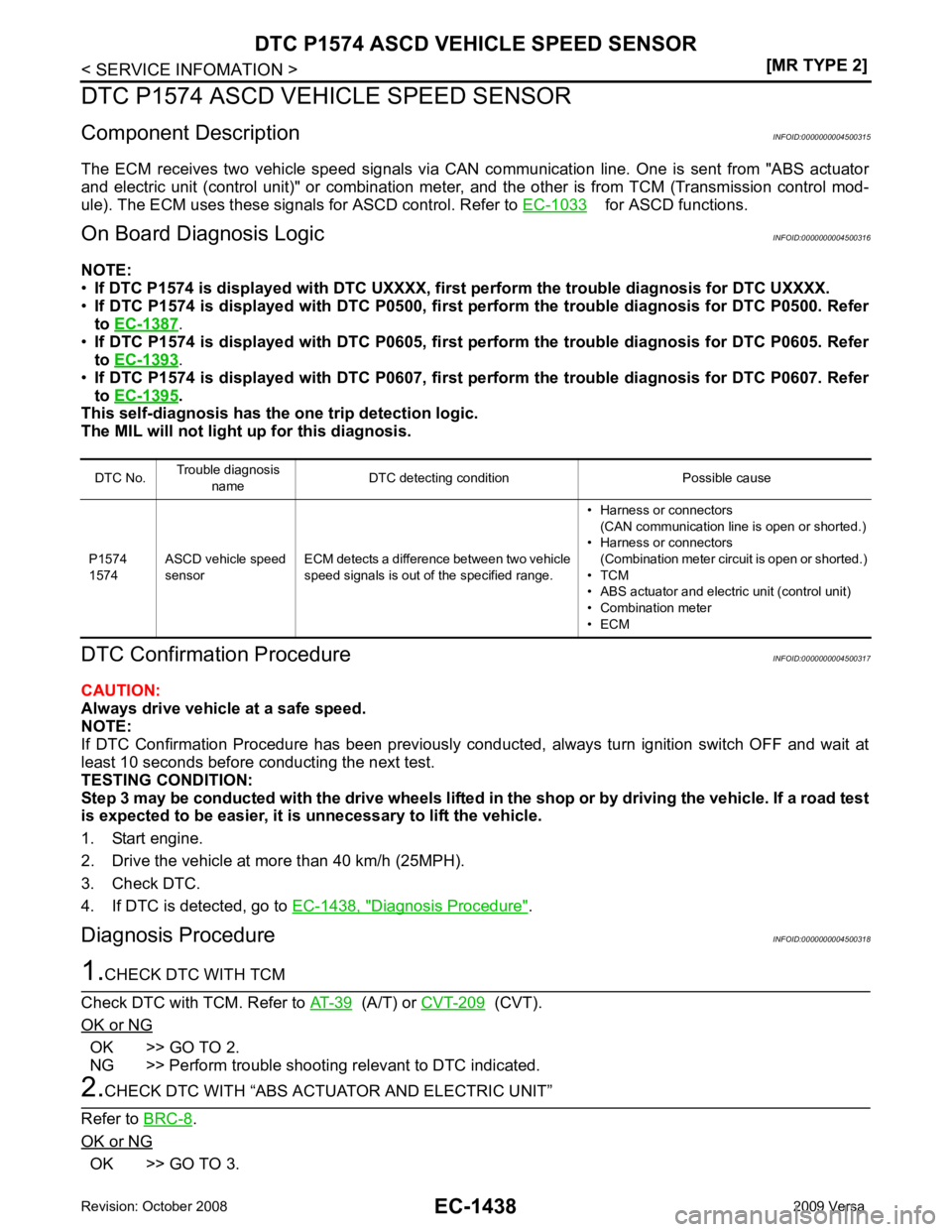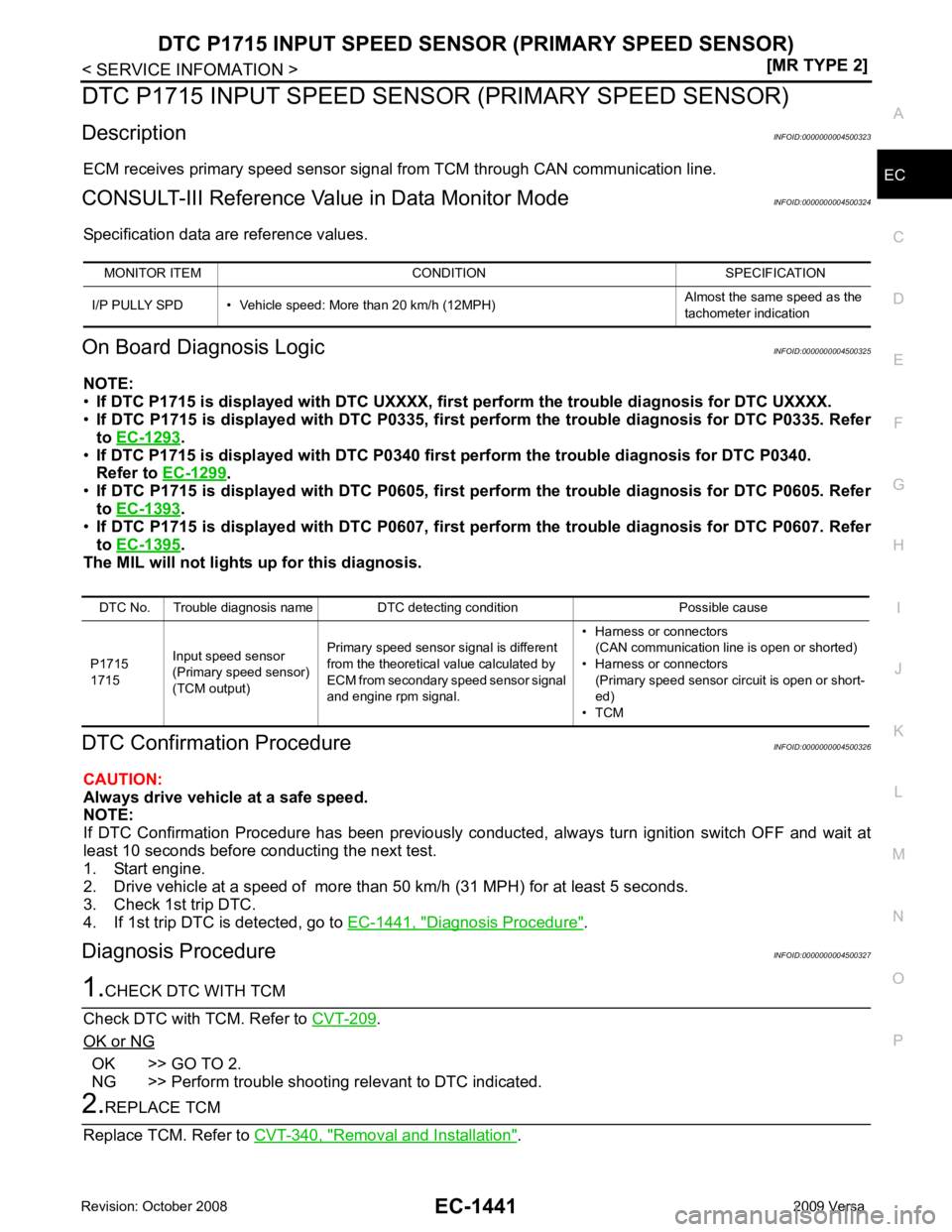2009 NISSAN LATIO check engine light
[x] Cancel search: check engine lightPage 2645 of 4331
![NISSAN LATIO 2009 Service Repair Manual DTC P0327, P0328 KS
EC-1289
< SERVICE INFOMATION >
[MR TYPE 2] C
D E
F
G H
I
J
K L
M A EC
NP
O
DTC P0327, P0328 KS
Component Description INFOID:0000000004500143
The knock sensor (1) is attached NISSAN LATIO 2009 Service Repair Manual DTC P0327, P0328 KS
EC-1289
< SERVICE INFOMATION >
[MR TYPE 2] C
D E
F
G H
I
J
K L
M A EC
NP
O
DTC P0327, P0328 KS
Component Description INFOID:0000000004500143
The knock sensor (1) is attached](/manual-img/5/57359/w960_57359-2644.png)
DTC P0327, P0328 KS
EC-1289
< SERVICE INFOMATION >
[MR TYPE 2] C
D E
F
G H
I
J
K L
M A EC
NP
O
DTC P0327, P0328 KS
Component Description INFOID:0000000004500143
The knock sensor (1) is attached to the cylinder block. It senses
engine knocking using a piezoelectric element. A knocking vibration
from the cylinder block is sensed as vibrational pressure. This pres-
sure is converted into a voltage signal and sent to the ECM.
• : Vehicle front
On Board Diagnosis Logic INFOID:0000000004500144
The MIL will not light up for these self-diagnoses.
DTC Confirmation Procedure INFOID:0000000004500145
NOTE:
If DTC Confirmation Procedure has been previously conduc ted, always turn ignition switch OFF and wait at
least 10 seconds before conducting the next test.
TESTING CONDITION:
Before performing the following procedure, confirm that battery voltage is more than 10V at idle.
1. Start engine and run it for at least 5 seconds at idle speed.
2. Check 1st trip DTC.
3. If 1st trip DTC is detected, go to EC-1291, " Diagnosis Procedure " . PBIB3264E
DTC No. Trouble Diagno
sis Name DTC Detected Co ndition Possible Cause
P0327
0327 Knock sensor circuit low
input An excessively low voltage from the sensor is
sent to ECM. • Harness or connectors
(Knock sensor circuit is open or shorted.)
• Knock sensor
P0328
0328 Knock sensor circuit high
input An excessively high voltage from the sensor is
sent to ECM.
Page 2668 of 4331
![NISSAN LATIO 2009 Service Repair Manual EC-1312< SERVICE INFOMATION >
[MR TYPE 2]
DTC P0441 EVAP CONTROL SYSTEM
With CONSULT-III
1. Disconnect vacuum hose connected to EVAP canister purge volume control solenoid valve at EVAP ser-
vice p NISSAN LATIO 2009 Service Repair Manual EC-1312< SERVICE INFOMATION >
[MR TYPE 2]
DTC P0441 EVAP CONTROL SYSTEM
With CONSULT-III
1. Disconnect vacuum hose connected to EVAP canister purge volume control solenoid valve at EVAP ser-
vice p](/manual-img/5/57359/w960_57359-2667.png)
EC-1312< SERVICE INFOMATION >
[MR TYPE 2]
DTC P0441 EVAP CONTROL SYSTEM
With CONSULT-III
1. Disconnect vacuum hose connected to EVAP canister purge volume control solenoid valve at EVAP ser-
vice port and install vacuum gauge. For the location of EVAP service port, refer to EC-1036, " Description " .
2. Start engine and let it idle.
3. Select “PURG VOL CONT/V” in “A CTIVE TEST” mode with CONSULT-III.
4. Rev engine up to 2,000 rpm.
5. Touch “Qd” and “Qu” on CONSULT-III screen to adjust “PURG VOL CONT/V” opening and check vacuum
existence.
OK or NG OK >> GO TO 7.
NG >> GO TO 4. 3.
CHECK PURGE FLOW
Without CONSULT-III
1. Start engine and warm it up to normal operating temperature.
2. Stop engine.
3. Disconnect vacuum hose connected to EVAP canister purge volume control solenoid valve at EVAP ser-
vice port and install vacuum gauge. For the location of EVAP service port, refer to EC-1036, " Description " .
4. Start engine and let it idle.
Do not depress accelerator pedal even slightly.
5. Check vacuum gauge indication before 60 seconds passed after starting engine.
6. Revving engine up to 2,000 rpm after 100 seconds passed after starting engine.
OK or NG OK >> GO TO 7.
NG >> GO TO 4. 4.
CHECK EVAP PURGE LINE
1. Turn ignition switch OFF.
2. Check EVAP purge line for improper connection or disconnection.
Refer to EC-1036, " Description " .
OK or NG OK >> GO TO 5.
NG >> Repair it. 5.
CHECK EVAP PURGE HOSE AND PURGE PORT
1. Disconnect purge hoses connected to EVAP service port A and
EVAP canister purge volume control solenoid valve B.
2. Blow air into each hose and EVAP purge port C.
PURG VOL CONT/V VACUUM
100% Should exist.
0% should not exist. Vacuum should not exist.
Vacuum should exist. SEF367U
Page 2682 of 4331
![NISSAN LATIO 2009 Service Repair Manual EC-1326< SERVICE INFOMATION >
[MR TYPE 2]
DTC P0443 EVAP CANISTER PURGE VO
LUME CONTROL SOLENOID VALVE
Do not use ECM ground terminals when measuring in put/output voltage. Doing so may result in dam- NISSAN LATIO 2009 Service Repair Manual EC-1326< SERVICE INFOMATION >
[MR TYPE 2]
DTC P0443 EVAP CANISTER PURGE VO
LUME CONTROL SOLENOID VALVE
Do not use ECM ground terminals when measuring in put/output voltage. Doing so may result in dam-](/manual-img/5/57359/w960_57359-2681.png)
EC-1326< SERVICE INFOMATION >
[MR TYPE 2]
DTC P0443 EVAP CANISTER PURGE VO
LUME CONTROL SOLENOID VALVE
Do not use ECM ground terminals when measuring in put/output voltage. Doing so may result in dam-
age to the ECM's transistor. Use a ground ot her than ECM terminals, such as the ground.
: Average voltage for pulse signal (Actual pulse signal can be confirmed by oscilloscope.)
Diagnosis Procedure INFOID:00000000045001831.
CHECK EVAP CANISTER PURGE VOLUME CONTROL SOLENOID VALVE POWER SUPPLY CIRCUIT
1. Turn ignition switch OFF.
2. Disconnect EVAP canister purge volume control solenoid valve (1) harness connector.
- EVAP service port (2)
- : Vehicle front
3. Turn ignition switch ON. TERMI-
NAL
NO. WIRE
COLOR ITEM CONDITION DATA (DC Voltage)
9 P EVAP canister purge volume
control solenoid valve [Engine is running]
• Idle speed
• Accelerator pedal: Not depressed even slightly, after engine starting. BATTERY VOLTAGE
(11 - 14V)
[Engine is running]
• Engine speed: About 2,000 rpm (More
than 100 seconds after starting engine) Approximately 10V
32 P ECM relay
(Self shut-off) [Engine is running]
[Ignition switch: OFF]
• For a few seconds after turning ignition switch OFF 0 - 1.0V
[Ignition switch: OFF]
• More than a few seconds after turning ig- nition switch OFF BATTERY VOLTAGE
(11 - 14V)
105 G Power supply for ECM [Ignition switch: ON]BATTERY VOLTAGE
(11 - 14V) PBIB0050E
PBIB0520E
BBIA0703E
Page 2689 of 4331
![NISSAN LATIO 2009 Service Repair Manual DTC P0444, P0445 EVAP CANISTER P
URGE VOLUME CONTROL SOLENOID
VALVE
EC-1333
< SERVICE INFOMATION >
[MR TYPE 2] C
D E
F
G H
I
J
K L
M A EC
NP
O
Do not use ECM ground terminals wh
en measuring input/ou NISSAN LATIO 2009 Service Repair Manual DTC P0444, P0445 EVAP CANISTER P
URGE VOLUME CONTROL SOLENOID
VALVE
EC-1333
< SERVICE INFOMATION >
[MR TYPE 2] C
D E
F
G H
I
J
K L
M A EC
NP
O
Do not use ECM ground terminals wh
en measuring input/ou](/manual-img/5/57359/w960_57359-2688.png)
DTC P0444, P0445 EVAP CANISTER P
URGE VOLUME CONTROL SOLENOID
VALVE
EC-1333
< SERVICE INFOMATION >
[MR TYPE 2] C
D E
F
G H
I
J
K L
M A EC
NP
O
Do not use ECM ground terminals wh
en measuring input/output voltage. Doing so may result in dam-
age to the ECM's transistor. Use a ground ot her than ECM terminals, such as the ground.
: Average voltage for pulse signal (Actual pulse signal can be confirmed by oscilloscope.)
Diagnosis Procedure INFOID:00000000045001911.
CHECK EVAP CANISTER PURG E VOLUME CONTROL SOLENOID VALVE POWER SUPPLY CIRCUIT
1. Turn ignition switch OFF.
2. Disconnect EVAP canister purge volume control solenoid valve (1) harness connector.
- EVAP canister port (2)
3. Turn ignition switch ON. TERMI-
NAL
NO. WIRE
COLOR ITEM CONDITION DATA (DC Voltage)
9 P EVAP canister purge volume
control solenoid valve [Engine is running]
• Idle speed
• Accelerator pedal: Not depressed even slightly, after engine starting. BATTERY VOLTAGE
(11 - 14V)
[Engine is running]
• Engine speed: About 2,000 rpm (More
than 100 seconds after starting engine) Approximately 10V
32 P ECM relay
(Self shut-off) [Engine is running]
[Ignition switch: OFF]
• For a few seconds after turning ignition switch OFF 0 - 1.0V
[Ignition switch: OFF]
• More than a few seconds after turning ig- nition switch OFF BATTERY VOLTAGE
(11 - 14V)
105 G Power supply for ECM [Ignition switch: ON]BATTERY VOLTAGE
(11 - 14V) PBIB0050E
PBIB0520E
BBIA0693E
Page 2705 of 4331
![NISSAN LATIO 2009 Service Repair Manual DTC P0451 EVAP CONTROL
SYSTEM PRESSURE SENSOR
EC-1349
< SERVICE INFOMATION >
[MR TYPE 2] C
D E
F
G H
I
J
K L
M A EC
NP
O
Do not depress accelerator pedal even slightly.
3. Check 1st trip DTC.
4. If 1 NISSAN LATIO 2009 Service Repair Manual DTC P0451 EVAP CONTROL
SYSTEM PRESSURE SENSOR
EC-1349
< SERVICE INFOMATION >
[MR TYPE 2] C
D E
F
G H
I
J
K L
M A EC
NP
O
Do not depress accelerator pedal even slightly.
3. Check 1st trip DTC.
4. If 1](/manual-img/5/57359/w960_57359-2704.png)
DTC P0451 EVAP CONTROL
SYSTEM PRESSURE SENSOR
EC-1349
< SERVICE INFOMATION >
[MR TYPE 2] C
D E
F
G H
I
J
K L
M A EC
NP
O
Do not depress accelerator pedal even slightly.
3. Check 1st trip DTC.
4. If 1st trip DTC is detected, go to EC-1349, " Diagnosis Procedure " .
Diagnosis Procedure INFOID:00000000045002121.
CHECK GROUND CONNECTIONS
1. Turn ignition switch OFF.
2. Loosen and retighten ground screws on the body.
Refer to EC-1144, " Ground Inspection " .
OK or NG OK >> GO TO 2.
NG >> Repair or replace ground connections. 2.
CHECK EVPA CONTROL SYS TEM PRESSURE SENSOR CONNECTOR FOR WATER
1. Disconnect EVAP control system pressure sensor (1) harness
connector.
- EVAP canister (2)
- EVAP canister vent control valve (3)
2. Check sensor harness connector for water.
OK or NG OK >> GO TO 3.
NG >> Repair or replace harness connector. 3.
CHECK COMPONENTS POWER SUPPLY
Check harness for short to power and short to ground, between the following terminals.
OK or NG OK >> GO TO 4.
NG >> Repair short to ground or short to power in harness or connectors. 4.
CHECK COMPONENTS
Check the following. :
Vehicle front
1. Body ground E24 2. Engine ground F9 3. engine ground F16
4. Body ground E15 BBIA0698E
Water should not exist.
BBIA0693E
ECM terminal Sensor terminal Reference Wiring Diagram
74 Refrigerant pressure sensor terminal 3 EC-1528, " Wiring Diagram "
75 Crankshaft position sensor (POS) terminal 1
EC-1294, " Wiring Diagram "
76 EVAP control system pressure sensor terminal 3
EC-1353, " Wiring Diagram "
102 APP sensor terminal 5
EC-1471, " Wiring Diagram "
Page 2794 of 4331

for ASCD functions.
On Board Diagn osis Logic INFOID:0000000004500316
NOTE:
• If DTC P1574 is displayed with DTC UXXXX, first perform the tr ouble diagnosis for DTC UXXXX.
• If DTC P1574 is displayed with DTC P0500, first pe rform the trouble diagnosis for DTC P0500. Refer
to EC-1387 .
This self-diagnosis has the one trip detection logic.
The MIL will not light up for this diagnosis.
DTC Confirmation Procedure INFOID:0000000004500317
CAUTION:
Always drive vehicle at a safe speed.
NOTE:
If DTC Confirmation Procedure has been previously conduc ted, always turn ignition switch OFF and wait at
least 10 seconds before conducting the next test.
TESTING CONDITION:
Step 3 may be conducted with the drive wheels lifted in the shop or by driving the vehicle. If a road test
is expected to be easier, it is unnecessary to lift the vehicle.
1. Start engine.
2. Drive the vehicle at more than 40 km/h (25MPH).
3. Check DTC.
4. If DTC is detected, go to EC-1438, " Diagnosis Procedure " .
Diagnosis Procedure INFOID:0000000004500318 (A/T) or
CVT-209 (CVT).
OK or NG OK >> GO TO 2.
NG >> Perform trouble shooting relevant to DTC indicated. .
OK or NG OK >> GO TO 3.DTC No.
Trouble diagnosis
name DTC detecting condition Possible cause
P1574
1574 ASCD vehicle speed
sensor ECM detects a difference between two vehicle
speed signals is out of the specified range. • Harness or connectors
(CAN communication line is open or shorted.)
• Harness or connectors (Combination meter circuit is open or shorted.)
• TCM
• ABS actuator and electric unit (control unit)
• Combination meter
• ECM
Page 2797 of 4331

EC
NP
O
DTC P1715 INPUT SPEED SENS
OR (PRIMARY SPEED SENSOR)
Description INFOID:0000000004500323
ECM receives primary speed sensor signal from TCM through CAN communication line.
CONSULT-III Reference Val ue in Data Monitor Mode INFOID:0000000004500324
Specification data are reference values.
On Board Diagnosis Logic INFOID:0000000004500325
NOTE:
• If DTC P1715 is displayed with DTC UXXXX, first perform the tr ouble diagnosis for DTC UXXXX.
• If DTC P1715 is displayed with DT C P0335, first perform the trouble diagnosis for DTC P0335. Refer
to EC-1293 .
• If DTC P1715 is displayed with DTC P0340 firs t perform the trouble diagnosis for DTC P0340.
Refer to EC-1299 .
• If DTC P1715 is displayed with DT C P0605, first perform the trouble diagnosis for DTC P0605. Refer
to EC-1393 .
• If DTC P1715 is displayed with DT C P0607, first perform the trouble diagnosis for DTC P0607. Refer
to EC-1395 .
The MIL will not lights up for this diagnosis.
DTC Confirmation Procedure INFOID:0000000004500326
CAUTION:
Always drive vehicle at a safe speed.
NOTE:
If DTC Confirmation Procedure has been previously conduc ted, always turn ignition switch OFF and wait at
least 10 seconds before conducting the next test.
1. Start engine.
2. Drive vehicle at a speed of more than 50 km/h (31 MPH) for at least 5 seconds.
3. Check 1st trip DTC.
4. If 1st trip DTC is detected, go to EC-1441, " Diagnosis Procedure " .
Diagnosis Procedure INFOID:0000000004500327.
OK or NG OK >> GO TO 2.
NG >> Perform trouble shooting relevant to DTC indicated. Removal and Installation " .
MONITOR ITEM CONDITION SPECIFICATION
I/P PULLY SPD • Vehicle speed: More than 20 km/h (12MPH) Almost the same speed as the
tachometer indication DTC No. Trouble diagnosis name DTC detecting condition Possible cause
P1715
1715 Input speed sensor
(Primary speed sensor)
(TCM output) Primary speed sensor signal is different
from the theoretical value calculated by
ECM from secondary speed sensor signal
and engine rpm signal. • Harness or connectors
(CAN communication line is open or shorted)
• Harness or connectors (Primary speed sensor circuit is open or short-
ed)
• TCM
Page 2799 of 4331

EC
NP
O
DTC P1805 BRAKE SWITCH
Description INFOID:0000000004500328
Brake switch signal is applied to the ECM through t he stop lamp switch when the brake pedal is depressed.
This signal is used mainly to decrease the engine speed when the vehicle is driving.
CONSULT-III Reference Val ue in Data Monitor Mode INFOID:0000000004500329
Specification data are reference values.
On Board Diagnosis Logic INFOID:0000000004500330
The MIL will not light up for this self-diagnosis.
FAIL-SAFE MODE When the malfunction is detected, the ECM enters in fail-safe mode.
DTC Confirmation Procedure INFOID:0000000004500331
1. Turn ignition switch ON.
2. Fully depress the brake pedal for at least 5 seconds.
3. Erase the DTC.
4. Check 1st trip DTC.
5. If 1st trip DTC is detected, go to EC-1445, " Diagnosis Procedure " .
MONITOR ITEM CONDITION SPECIFICATION
BRAKE SW • Ignition switch: ON Brake pedal: Fully released OFF
Brake pedal: Slightly depressed ON DTC No. Trouble diagnosis name DTC detecting condition Possible cause
P1805
1805 Brake switch A brake switch signal is not sent to ECM for
extremely long time while the vehicle is driv-
ing. • Harness or connectors
(Stop lamp switch circuit is open or shorted.)
• Stop lamp switch Engine operation condition in fail-fail safe mode
ECM controls the electric throttle control actuator by regulating the throttle opening to a small range. Therefore, acceleration will be poor.
Vehicle condition Driving condition Engine: Idling NormalAccelerating Poor acceleration